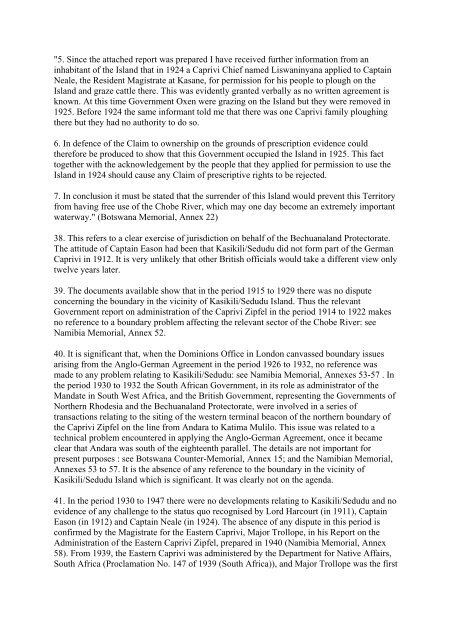botswana/namibia - Cour international de Justice
botswana/namibia - Cour international de Justice
botswana/namibia - Cour international de Justice
You also want an ePaper? Increase the reach of your titles
YUMPU automatically turns print PDFs into web optimized ePapers that Google loves.
"5. Since the attached report was prepared I have received further information from an<br />
inhabitant of the Island that in 1924 a Caprivi Chief named Liswaninyana applied to Captain<br />
Neale, the Resi<strong>de</strong>nt Magistrate at Kasane, for permission for his people to plough on the<br />
Island and graze cattle there. This was evi<strong>de</strong>ntly granted verbally as no written agreement is<br />
known. At this time Government Oxen were grazing on the Island but they were removed in<br />
1925. Before 1924 the same informant told me that there was one Caprivi family ploughing<br />
there but they had no authority to do so.<br />
6. In <strong>de</strong>fence of the Claim to ownership on the grounds of prescription evi<strong>de</strong>nce could<br />
therefore be produced to show that this Government occupied the Island in 1925. This fact<br />
together with the acknowledgement by the people that they applied for permission to use the<br />
Island in 1924 should cause any Claim of prescriptive rights to be rejected.<br />
7. In conclusion it must be stated that the surren<strong>de</strong>r of this Island would prevent this Territory<br />
from having free use of the Chobe River, which may one day become an extremely important<br />
waterway." (Botswana Memorial, Annex 22)<br />
38. This refers to a clear exercise of jurisdiction on behalf of the Bechuanaland Protectorate.<br />
The attitu<strong>de</strong> of Captain Eason had been that Kasikili/Sedudu did not form part of the German<br />
Caprivi in 1912. It is very unlikely that other British officials would take a different view only<br />
twelve years later.<br />
39. The documents available show that in the period 1915 to 1929 there was no dispute<br />
concerning the boundary in the vicinity of Kasikili/Sedudu Island. Thus the relevant<br />
Government report on administration of the Caprivi Zipfel in the period 1914 to 1922 makes<br />
no reference to a boundary problem affecting the relevant sector of the Chobe River: see<br />
Namibia Memorial, Annex 52.<br />
40. It is significant that, when the Dominions Office in London canvassed boundary issues<br />
arising from the Anglo-German Agreement in the period 1926 to 1932, no reference was<br />
ma<strong>de</strong> to any problem relating to Kasikili/Sedudu: see Namibia Memorial, Annexes 53-57 . In<br />
the period 1930 to 1932 the South African Government, in its role as administrator of the<br />
Mandate in South West Africa, and the British Government, representing the Governments of<br />
Northern Rho<strong>de</strong>sia and the Bechuanaland Protectorate, were involved in a series of<br />
transactions relating to the siting of the western terminal beacon of the northern boundary of<br />
the Caprivi Zipfel on the line from Andara to Katima Mulilo. This issue was related to a<br />
technical problem encountered in applying the Anglo-German Agreement, once it became<br />
clear that Andara was south of the eighteenth parallel. The <strong>de</strong>tails are not important for<br />
present purposes : see Botswana Counter-Memorial, Annex 15; and the Namibian Memorial,<br />
Annexes 53 to 57. It is the absence of any reference to the boundary in the vicinity of<br />
Kasikili/Sedudu Island which is significant. It was clearly not on the agenda.<br />
41. In the period 1930 to 1947 there were no <strong>de</strong>velopments relating to Kasikili/Sedudu and no<br />
evi<strong>de</strong>nce of any challenge to the status quo recognised by Lord Harcourt (in 1911), Captain<br />
Eason (in 1912) and Captain Neale (in 1924). The absence of any dispute in this period is<br />
confirmed by the Magistrate for the Eastern Caprivi, Major Trollope, in his Report on the<br />
Administration of the Eastern Caprivi Zipfel, prepared in 1940 (Namibia Memorial, Annex<br />
58). From 1939, the Eastern Caprivi was administered by the Department for Native Affairs,<br />
South Africa (Proclamation No. 147 of 1939 (South Africa)), and Major Trollope was the first

















